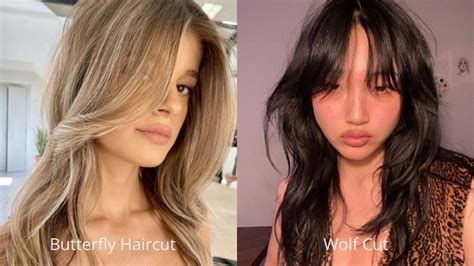Introduction
The hair game of 2023 welcomes two enticing haircuts that have taken the internet by storm: the butterfly cut and the wolf cut. Both styles boast unique features and cater to different preferences, sparking a debate among fashion-forward individuals. This in-depth analysis will delve into the intricacies of each cut, empowering you to make an informed choice for your next salon visit.

The Butterfly Cut: A Graceful Flutter of Layers
The butterfly cut, also known as the “bixie,” is a hybrid style that combines the essence of bobs and pixie cuts. Characterized by soft, face-framing layers that resemble butterfly wings, this cut creates an illusion of volume and movement.
- Key Features:
- Short, layered hair with longer pieces in the front
- Zero to minimal graduation
-
Feminine and flattering for most face shapes
-
Pros:
- Versatile styling options
- Low maintenance, requiring minimal styling effort
-
Adds volume and movement to thin hair
-
Cons:
- May not be suitable for those with very thick hair
- Regular trims are necessary to maintain the shape
The Wolf Cut: A Rebellious Mix of Texture and Volume
The wolf cut, inspired by the untamed spirit of the wilderness, showcases a blend of shaggy layers and disconnected ends. It’s a trendsetting style that embodies a youthful and edgy aesthetic.
- Key Features:
- Long, layered hair with short, choppy layers at the crown
- Graduated layers throughout
-
Voluminous and shaggy, with a messy, lived-in look
-
Pros:
- Adds instant volume and texture
- Flattering for most face shapes
-
Can be styled in various ways
-
Cons:
- Requires more styling effort than the butterfly cut
- May be difficult to manage for those with thick or curly hair
- Regular trims are crucial to remove split ends
Comparative Analysis
| Feature | Butterfly Cut | Wolf Cut |
|---|---|---|
| Length | Short to medium | Long to medium |
| Layers | Soft, face-framing | Shaggy, disconnected |
| Graduation | Minimal to none | Graduated throughout |
| Volume | Moderate | High |
| Maintenance | Low | Moderate |
| Versatility | Moderate | High |
| Face Shapes | Most | Most |
Choosing the Right Cut for You
The choice between a butterfly cut and a wolf cut depends on your individual style, hair texture, and lifestyle.
-
Butterfly Cut: Ideal for those seeking a feminine, flattering, and low-maintenance cut. Suitable for most face shapes and hair types.
-
Wolf Cut: Perfect for those who desire a bolder, edgier look with plenty of volume and texture. Can be styled in various ways to complement different face shapes and hair textures.
Variations and Inspirations
Both the butterfly cut and wolf cut offer endless variations to match personal preferences.
- Butterfly Cut:
- Jagged Butterfly Cut: Features more pronounced, layered angles reminiscent of butterfly wings.
- Asymmetrical Butterfly Cut: Creates a distinct visual interest by cutting one side of the hair longer than the other.
-
Shaggy Butterfly Cut: Incorporates choppier layers for a more textured, lived-in feel.
-
Wolf Cut:
- Mullet Wolf Cut: Exhibits a more pronounced graduation from long to short layers, resembling a mullet hairstyle.
- Shaggy Wolf Cut: Emphasizes shaggy layers throughout the entire hair, resulting in a voluminous, untamed look.
- Layered Wolf Cut: Focuses on creating defined layers of different lengths, offering more versatility in styling.
Pain Points and Motivations
Pain Points:
- Difficulty Styling Thick Hair: Both the butterfly cut and wolf cut can be challenging to style for those with thick hair, as the layers may not distribute volume evenly.
- Regular Trims: Both cuts require regular trims to maintain their shape and prevent split ends.
- Styling Time: The wolf cut requires more styling time and effort due to its shaggier layers.
Motivations:
- Desire for Volume: Both cuts add significant volume to the hair, making them ideal for those with thin or flat hair.
- Edgy and Unique Look: The wolf cut, in particular, appeals to individuals seeking a bold and rebellious hair statement.
- Easy Styling: The butterfly cut offers a low-maintenance option for those with busy lifestyles.
FAQs
1. Can I style a butterfly cut with bangs?
Yes, bangs can complement a butterfly cut, adding extra texture and framing the face.
2. How often should I trim a wolf cut?
Regular trims every 6-8 weeks are recommended to remove split ends and maintain the desired shape.
3. Can a wolf cut be layered underneath?
Yes, layering the hair underneath can add texture and volume to the cut.
4. Is the wolf cut suitable for curly hair?
Yes, the wolf cut can be adapted to suit curly hair by using softer layers and avoiding excessive graduation.
5. Which cut is more versatile?
The wolf cut offers more versatility in styling due to its shaggier layers, which can be styled in various ways.
6. Can I transition from a butterfly cut to a wolf cut?
Yes, it is possible to transition by gradually adding more layers and texture over time.
7. What are some alternative cuts to consider?
Other popular cuts include the shag cut, the mullet, and the pixie cut.
8. Can I style the wolf cut without heat?
Yes, using air-drying techniques and products that enhance natural texture can achieve a stylish wolf cut look.
Conclusion
The butterfly cut and the wolf cut are two captivating haircut trends that cater to diverse preferences. Whether you desire a feminine, low-maintenance cut or a bold, edgy statement, these styles offer a multitude of variations to suit your unique personality. By carefully considering the key distinctions, pain points, and motivations, you can make an informed choice and embrace the transformative power of a new haircut.
